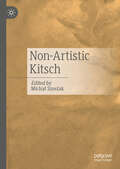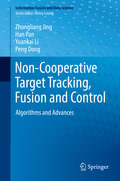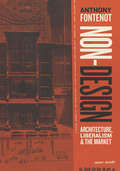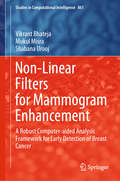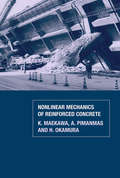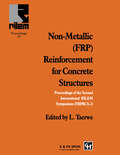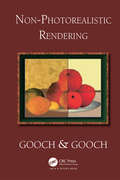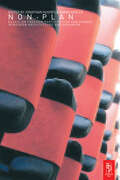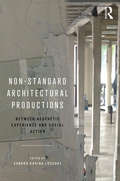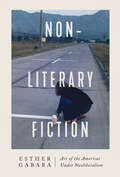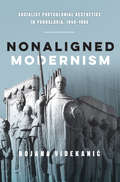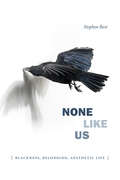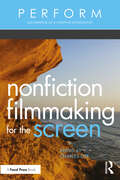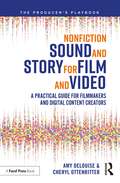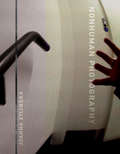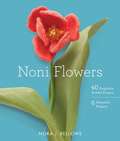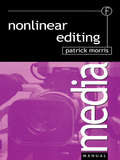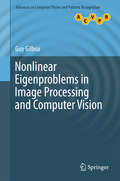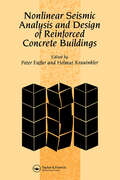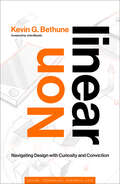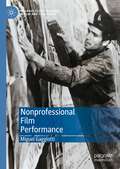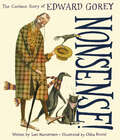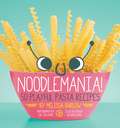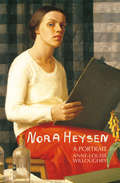- Table View
- List View
Non-Artistic Kitsch
by Michał SzostakThe book aims to provide a contemporary individual with an extensive but focused set of examples of kitsch in non-artistic spheres to create theoretical and practical backgrounds for conscious recognition of kitsch in fields like psychology, education, politics, law, religion, terrorism, television, or journalism. Two perspectives are underlined: 1) the consciousness of the presence and role of kitsch experience within the philosophy of living and 2) the management of kitsch experience within the philosophy of living (kitsch as a means for achieving goals). Due to the diverse topics covered by particular chapters, no unified methodology is applied in the whole volume. However, due to the kitsch’s complex and metaphysical character, the only fundament is using the “kitsch experience theory” (Szostak and Sułkowski, 2020) to narrate the volume coherently. The authors apply a qualitative methodological approach, extensively using case studies, comparative analyses, and ethnographic focus.
Non-Cooperative Target Tracking, Fusion and Control: Algorithms and Advances (Information Fusion and Data Science)
by Zhongliang Jing Han Pan Yuankai Li Peng DongThis book gives a concise and comprehensive overview of non-cooperative target tracking, fusion and control. Focusing on algorithms rather than theories for non-cooperative targets including air and space-borne targets, this work explores a number of advanced techniques, including Gaussian mixture cardinalized probability hypothesis density (CPHD) filter, optimization on manifold, construction of filter banks and tight frames, structured sparse representation, and others. Containing a variety of illustrative and computational examples, Non-cooperative Target Tracking, Fusion and Control will be useful for students as well as engineers with an interest in information fusion, aerospace applications, radar data processing and remote sensing.
Non-Design: Architecture, Liberalism, and the Market
by Anthony FontenotAnthony Fontenot’s staggeringly ambitious book uncovers the surprisingly libertarian heart of the most influential British and American architectural and urbanist discourses of the postwar period, expressed as a critique of central design and a support of spontaneous order. Non-Design illuminates the unexpected philosophical common ground between enemies of state support, most prominently the economist Friedrich Hayek, and numerous notable postwar architects and urbanists like Robert Venturi, Denise Scott Brown, Reyner Banham, and Jane Jacobs. These thinkers espoused a distinctive concept of "non-design,"characterized by a rejection of conscious design and an embrace of various phenomenon that emerge without intention or deliberate human guidance. This diffuse and complex body of theories discarded many of the cultural presuppositions of the time, shunning the traditions of modern design in favor of the wisdom, freedom, and self-organizing capacity of the market. Fontenot reveals the little-known commonalities between the aesthetic deregulation sought by ostensibly liberal thinkers and Hayek’s more controversial conception of state power, detailing what this unexplored affinity means for our conceptions of political liberalism. Non-Design thoroughly recasts conventional views of postwar architecture and urbanism, as well as liberal and libertarian philosophies.
Non-Design: Architecture, Liberalism, and the Market
by Anthony FontenotAnthony Fontenot’s staggeringly ambitious book uncovers the surprisingly libertarian heart of the most influential British and American architectural and urbanist discourses of the postwar period, expressed as a critique of central design and a support of spontaneous order. Non-Design illuminates the unexpected philosophical common ground between enemies of state support, most prominently the economist Friedrich Hayek, and numerous notable postwar architects and urbanists like Robert Venturi, Denise Scott Brown, Reyner Banham, and Jane Jacobs. These thinkers espoused a distinctive concept of "non-design,"characterized by a rejection of conscious design and an embrace of various phenomenon that emerge without intention or deliberate human guidance. This diffuse and complex body of theories discarded many of the cultural presuppositions of the time, shunning the traditions of modern design in favor of the wisdom, freedom, and self-organizing capacity of the market. Fontenot reveals the little-known commonalities between the aesthetic deregulation sought by ostensibly liberal thinkers and Hayek’s more controversial conception of state power, detailing what this unexplored affinity means for our conceptions of political liberalism. Non-Design thoroughly recasts conventional views of postwar architecture and urbanism, as well as liberal and libertarian philosophies.
Non-Linear Filters for Mammogram Enhancement: A Robust Computer-aided Analysis Framework for Early Detection of Breast Cancer (Studies in Computational Intelligence #861)
by Vikrant Bhateja Shabana Urooj Mukul MisraThis book presents non-linear image enhancement approaches to mammograms as a robust computer-aided analysis solution for the early detection of breast cancer, and provides a compendium of non-linear mammogram enhancement approaches: from the fundamentals to research challenges, practical implementations, validation, and advances in applications.The book includes a comprehensive discussion on breast cancer, mammography, breast anomalies, and computer-aided analysis of mammograms. It also addresses fundamental concepts of mammogram enhancement and associated challenges, and features a detailed review of various state-of-the-art approaches to the enhancement of mammographic images and emerging research gaps. Given its scope, the book offers a valuable asset for radiologists and medical experts (oncologists), as mammogram visualization can enhance the precision of their diagnostic analyses; and for researchers and engineers, as the analysis of non-linear filters is one of the most challenging research domains in image processing.
Non-Linear Mechanics of Reinforced Concrete
by K. Maekawa H. Okamura A. PimanmasThis book describes the application of nonlinear static and dynamic analysis for the design, maintenance and seismic strengthening of reinforced concrete structures. The latest structural and RC constitutive modelling techniques are described in detail, with particular attention given to multi-dimensional cracking and damage assessment, and their p
Non-Metallic (FRP) Reinforcement for Concrete Structures: Proceedings of the Second International RILEM Symposium
by L. TaerweDealing with a wide range of non-metallic materials, this book opens up possibilities of lighter, more durable structures. With contributions from leading international researchers and design engineers, it provides a complete overview of current knowledge on the subject.
Non-Photorealistic Rendering
by Bruce Gooch Amy GoochThe ubiquity of computer-generated imagery around us, in movies, advertising or on the Internet is already being taken for granted and what impresses most people is the photorealistic quality of the images. Pictures, as we have often been told, are worth a thousand words and the information transported by an image can take many different forms. Man
Non-Plan: Essays on Freedom, Participation and Change in Modern Architecture and Urbanism
by Jonathan Hughes Simon SadlerNon-Plan explores ways of involving people in the design of their environments - a goal which transgresses political categories of 'right' and 'left'. Attempts to circumvent planning bureaucracy and architectural inertia have ranged from free-market enterprise zones, to self-build housing, and from squatting to sophisticated technologies of prefabrication. Yet all have shared in a desire to let people shape the built environment they want to live and work in.How can buildings better reflect the needs of their inhabitants? How can cities better facilitate the work and recreation of their many populaces? Modernism had promised a functionalist approach to resolving the architectural needs of the twentieth-century, yet the design of cities and buildings often appears to confound the needs of those who use them - their design and layout being highly regulated by restrictive legislation, planning controls and bureaucracy.Non-Plan considers the theoretical and conceptual frameworks within which architecture and urbanism have sought to challenge entrenched boundaries of control, focusing on the architectural history of the post-war period to the present day. This provocative book will be of interest to architects, planners and students of architecture, design, town-planning and architectural history. Its contributors include architects, critics and historians, including many whose work helped shape the Non-Plan debate during the period. List of contributors: Cedric Price, Benjamin Franks, Elizabeth Lebas, Eleonore Kofman, Ben Highmore, Yona Friedman, Paul Barker, Clara Greed, Barry Curtis, Colin Ward, Ian Horton, John Beck, Chinedu Umenyilora and Malcolm Miles.
Non-Standard Architectural Productions: Between Aesthetic Experience and Social Action
by Sandra Karina LöschkeThis book captures concepts and projects that reshape the discipline of architecture by prioritizing people over buildings. In doing so, it uncovers sophisticated approaches that go beyond standard architectural protocols to explore experience-based aesthetics, encounters, action-based research, critical practices, and social engagement. If these are widely understood as singular or incompatible approaches, the book reveals that they form a growing network of interrelations and generate levels of flexibility and dynamism that are reshaping the discipline. The thirteen chapters analyze thought-provoking projects – branded museums, restaged exhibitions, home/work spaces, multi-cultural spaces, ageing apartment blocks, abandoned homes, and urban slums amongst them. Together, they enliven the stalled debate about a single architectural response to the complex challenges of the contemporary world by highlighting pluralistic perspectives on architecture that offer fresh solutions on how architecture can improve people’s lives. Featuring essays from an international range of authors, this book makes a vital contribution to our understanding of the wider conditions under which, and in relation to which, contemporary architecture is produced.
Non-literary Fiction: Art of the Americas under Neoliberalism
by Esther GabaraExplores a new form of fiction that emerged in late-twentieth-century visual art across the Americas. With Non-literary Fiction, Esther Gabara examines how contemporary art produced across the Americas has reacted to the rising tide of neoliberal regimes, focusing on the crucial role of fiction in daily politics. Gabara argues that these fictions depart from familiar literary narrative structures and emerge in the new mediums and practices that have revolutionized contemporary art. Each chapter details how fiction is created through visual art forms—in performance and body art, posters, mail art, found objects, and installations. For Gabara, these fictions comprise a type of art that asks viewers to collaborate in the creation of the work and helps them to withstand the brutal restrictions imposed by dominant neoliberal regimes. During repressive regimes of the 1960s and 1970s and free trade agreements of the 1990s, artists and critics consistently said no to economic privatization, political deregulation, and reactionary social logic as they rejected inherited notions of visual, literary, and political representation. Through close analyses of artworks and writings by leading figures of these two generations, including Indigenous thinkers, Gabara shows how negation allows for the creation of fiction outside textual forms of literature.
Nonaligned Modernism: Socialist Postcolonial Aesthetics in Yugoslavia, 1945–1985
by Bojana VidekanićIn less than half a century, the Socialist Federal Republic of Yugoslavia successfully defeated Fascist occupation, fended off dominating pressures from the Eastern and Western blocs, built a modern society on the ashes of war, created its own form of socialism, and led the formation of the Nonaligned Movement. This country's principles and its continued battles, fought against all odds, provided the basis for dynamic and exceptional forms of art. <p><p>Drawing on archival materials, postcolonial theory, and Eastern European socialist studies, Nonaligned Modernism chronicles the emergence of late modernist artistic practices in Yugoslavia from the end of the Second World War to the mid-1980s. Situating Yugoslav modernism within postcolonial artistic movements of the twentieth century, Bojana Videkanic explores how cultural workers collaborated with others from the Global South to create alternative artistic and cultural networks that countered Western hegemony. Videkanic focuses primarily on art exhibitions along with examples of international cultural exchange to demonstrate that nonaligned art wove together politics and aesthetics, and indigenous, Western, and global influences. <p><p>An interdisciplinary book, Nonaligned Modernism highlights Yugoslavia's key role in the creation of a global modernist ethos and international postcolonial culture.
None Like Us: Blackness, Belonging, Aesthetic Life (Theory Q)
by Stephen BestIt passes for an unassailable truth that the slave past provides an explanatory prism for understanding the black political present. In None Like Us Stephen Best reappraises what he calls “melancholy historicism”—a kind of crime scene investigation in which the forensic imagination is directed toward the recovery of a “we” at the point of “our” violent origin. Best argues that there is and can be no “we” following from such a time and place, that black identity is constituted in and through negation, taking inspiration from David Walker’s prayer that “none like us may ever live again until time shall be no more.” Best draws out the connections between a sense of impossible black sociality and strains of negativity that have operated under the sign of queer. In None Like Us the art of El Anatsui and Mark Bradford, the literature of Toni Morrison and Gwendolyn Brooks, even rumors in the archive, evidence an apocalyptic aesthetics, or self-eclipse, which opens the circuits between past and present and thus charts a queer future for black study.
Nonfiction Filmmaking for the Screen (PERFORM)
by Charles DyeCombining essays and interviews with nonfiction filmmakers, this collection explores the business side of nonfiction media creation for film and television. Over 30 industry professionals dispel myths about the industry and provide practical advice on topics such as how to break into the field; how to develop, nurture, and navigate business relationships; and how to do creative work under pressure. Readers will also learn about the entrepreneurial expectations in relation to marketing, strategies for contending with the emotional highs and lows of creating nonfiction media, and money management whilst pursuing a career in creating nonfiction media. Written for undergraduates and graduates studying filmmaking, media production, and documentary filmmaking, as well as aspiring nonfiction media creators and documentary filmmakers, this book provides readers with a wealth of first-hand information that will help them create their own opportunities and pursue a career in nonfiction film and television.
Nonfiction Sound and Story for Film and Video: A Practical Guide for Filmmakers and Digital Content Creators (The Producer's Playbook)
by Amy DeLouise Cheryl OttenritterThis book guides nonfiction storytellers in the art of creatively and strategically using sound to engage their audience and bring stories to life. Sound is half of film and video storytelling, and yet its importance is often overlooked until a post-production emergency arises. Written by two experienced creators—one a seasoned nonfiction producer/director with a background in music, and one a sound designer who owns a well-regarded mix studio—this book teaches nonfiction producers, filmmakers, and branded content creators how to reimagine their storytelling by improving sound workflow from field to post. In addition to real-world examples from the authors’ own experiences, interviews with and examples from industry professionals across many genres of nonfiction production are included throughout. Written in a conversational style, the book pinpoints practical topics and considerations like 360 video and viewer accessibility. As such, it is a vital point of reference for all nonfiction filmmakers, directors, and producers, or anyone wanting to learn how to improve their storytelling. An accompanying Companion Website offers listening exercises, production sound layout diagrams, templates, and other resources.
Nonhuman Photography (The\mit Press Ser.)
by Joanna ZylinskaA new philosophy of photography that goes beyond humanist concepts to consider imaging practices from which the human is absent, as both subject and agent.Today, in the age of CCTV, drones, medical body scans, and satellite images, photography is increasingly decoupled from human agency and human vision. In Nonhuman Photography, Joanna Zylinska offers a new philosophy of photography, going beyond the human-centric view to consider imaging practices from which the human is absent. Zylinska argues further that even those images produced by humans, whether artists or amateurs, entail a nonhuman, mechanical element—that is, they involve the execution of technical and cultural algorithms that shape our image-making devices as well as our viewing practices. At the same time, she notes, photography is increasingly mobilized to document the precariousness of the human habitat and tasked with helping us imagine a better tomorrow. With its conjoined human-nonhuman agency and vision, Zylinska claims, photography functions as both a form of control and a life-shaping force.Zylinska explores the potential of photography for developing new modes of seeing and imagining, and presents images from her own photographic project, Active Perceptual Systems. She also examines the challenges posed by digitization to established notions of art, culture, and the media. In connecting biological extinction and technical obsolescence, and discussing the parallels between photography and fossilization, she proposes to understand photography as a light-induced process of fossilization across media and across time scales.
Noni Flowers: 40 Exquisite Knitted Flowers
by Nora BellowsDesigner Nora J. Bellows's extraordinary Noni® bag and flower patterns have earned her acclaim and endeared her to a loyal following of knitters all over the world. Now, in her first book, she offers lifelike knitted flowers that rival the beauty of true botanicals. This is a collection of luscious designs and essential techniques that knitters will turn to again and again. Inside, you'll find: * 40 exceptional knitted and felted flowers, from Angel's Tears Ddaffodils to ylang ylang * 6 beautiful yet practical garment, accessory, and home projects perfect for floral embellishment * Clear instructions for knitting, felting, wiring, and finishing your work
Nonlinear Editing (Media Manuals Ser.)
by Patrick MorrisNonlinear is a buzzword for every broadcaster and facility house worldwide. Systems range from the humble to the exotic, and despite the growing acceptance of the technology, many users, both new and experienced, find the complexity of the operation and the time spent loading the material and rendering effects difficult to manage at first. Non-linear editing also comes with its own specialist language, requiring each editor to be conversant with a new range of skills from day one. As desktop systems improve the role of the traditional editor is constantly evolving and expanding. This is an operational manual for professional trainees and students in the post-production industry. It will also serve as a useful reference tool for producers and directors. Written in a concise and clear manner, the book serves as a practical guide to the efficient management and operation of non-linear editing systems. It describes the technology involved, the essential techniques to be mastered including on-line and off-line editing, project management, rendering effects, working with graphics and audio, and adding third party applications. Designed for quick and easy reference, this is a practical user guide to non-linear editing that comes complete with an extensive jargon buster that will get you fully conversant with the technology in a short space of time.Patrick Morris is a Trainer in Post-Production for the Television Corporation of Singapore and the Singapore Broadcasting Authority as well as Chairman of the South East Asia User Group. He is an AVID Certified Trainer with a working knowledge of Lightworks, Media 100, Quantel, D Vision and other systems. Formerly a consultant and Senior Editor for BBC, ITV and SKY TV, he also spent many years a Training Manager for BBC Wood Norton and as Senior Video-Tape Editor for Television South West.
Nonlinear Eigenproblems in Image Processing and Computer Vision (Advances in Computer Vision and Pattern Recognition)
by Guy GilboaThis unique text/reference presents a fresh look at nonlinear processing through nonlinear eigenvalue analysis, highlighting how one-homogeneous convex functionals can induce nonlinear operators that can be analyzed within an eigenvalue framework. The text opens with an introduction to the mathematical background, together with a summary of classical variational algorithms for vision. This is followed by a focus on the foundations and applications of the new multi-scale representation based on non-linear eigenproblems. The book then concludes with a discussion of new numerical techniques for finding nonlinear eigenfunctions, and promising research directions beyond the convex case.Topics and features: introduces the classical Fourier transform and its associated operator and energy, and asks how these concepts can be generalized in the nonlinear case; reviews the basic mathematical notion, briefly outlining the use of variational and flow-based methods to solve image-processing and computer vision algorithms; describes the properties of the total variation (TV) functional, and how the concept of nonlinear eigenfunctions relate to convex functionals; provides a spectral framework for one-homogeneous functionals, and applies this framework for denoising, texture processing and image fusion; proposes novel ways to solve the nonlinear eigenvalue problem using special flows that converge to eigenfunctions; examines graph-based and nonlocal methods, for which a TV eigenvalue analysis gives rise to strong segmentation, clustering and classification algorithms; presents an approach to generalizing the nonlinear spectral concept beyond the convex case, based on pixel decay analysis; discusses relations to other branches of image processing, such as wavelets and dictionary based methods.This original work offers fascinating new insights into established signal processing techniques, integrating deep mathematical concepts from a range of different fields, which will be of great interest to all researchers involved with image processing and computer vision applications, as well as computations for more general scientific problems.
Nonlinear Seismic Analysis and Design of Reinforced Concrete Buildings: Workshop on Nonlinear Seismic Analysis of Reinforced Concrete Buildings, Bled, Slovenia, Yugoslavia, 13-16 July 1992
by P. Fajfar H. KrawinklerForty scientists working in 13 different countries detail in this work the most recent advances in seismic design and performance assessment of reinforced concrete buildings. It is a valuable contribution in the mitigation of natural disasters.
Nonlinear: Navigating Design with Curiosity and Conviction (Simplicity: Design, Technology, Business, Life)
by Kevin G. BethuneFrom the acclaimed designer and bestselling author of Reimagining Design, a nonlinear approach to navigating design&’s nuances in pursuit of meaningful innovation.In Nonlinear, Kevin Bethune shows us that we can reject trodden paths of digital or physical product creation by taking advantage of a nonlinear approach. To unlock meaningful innovation that breeds new and novel outcomes, he writes, teams need to embark on a journey into the proverbial forest of ambiguity, the result of a rapidly converging, dynamic, and exponentially changing landscape. The journey is less about getting it right or wrong, and more about using the information we have at our disposal to understand our choices and unlock new learning. Nonlinear begins by taking the reader through Bethune&’s professional zigs and zags. The author explains that while his interdisciplinary leaps were rare at the time he took them, these varied experiences unlocked perspectives about design and innovation that uniquely prepared him for our present moment and for the future. He then showcases the role of quantitative information to strategically frame and set boundary conditions for our creative exploration, and he highlights the role of qualitative insights to provide the substance necessary to begin crafting solutions that address unmet needs. The book also identifies accelerants (or flywheels) that will help readers as they reflect on their journey through the forest of ambiguity, with a specific emphasis on diversity, a key theme for Bethune, a Black man who has navigated new horizons. Readers will enjoy having the chance to customize the author&’s perspectives and make them their own at both an individual and a team level.
Nonprofessional Film Performance (Palgrave Close Readings in Film and Television)
by Miguel GaggiottiThis book offers a critical account of film performances by nonprofessional actors. Nonprofessional actors — actors without previous acting training or experience — have performed in films since the days of the Lumière brothers. Generally associated with currents such as Early Soviet Cinema, Italian Neorealism and New Argentine Cinema, nonprofessional actors also feature prominently in the works of celebrated directors including Pier Paolo Pasolini, Robert Bresson and Joanna Hogg. Since the turn of the century and the rise of digital filmmaking, the performances of nonprofessional actors have remained a staple of independent cinemas from all over the world, including films associated with the loose trend often referred to as Slow Cinema. Despite their enduring presence in acclaimed and widely discussed films, nonprofessional actors have received scant scholarly attention. This book proposes to analyse exemplary nonprofessional performances from across the history of cinema as a means of illuminating their significance and celebrating the performers’ contributions to the films.
Nonsense! the Curious Story of Edward Gorey
by Lori MortensenA beautifully illustrated and lyrical picture-book biography of eccentric and beloved writer and artist Edward Gorey In this lyrical biography of one of literature&’s most creepily creative authors and illustrators, kids will learn about the inspiration behind a generation of creators, from Lemony Snicket to Tim Burton. Known for, among other things, wearing a large fur coat wherever he went, storyteller Edward Gorey was respected for both his brilliance and his eccentricity. As a child, he taught himself to read and skipped several grades before landing at Harvard (after a brief stint in the army). Then he built a name for himself as a popular book illustrator. After that, he went on to publish well over one hundred of his own books, stories that mingled sweetness and innocence, danger and darkness, all mixed with his own brand of silliness. Illustrated with Gorey-like humor and inspiration by Chloe Bristol, this stunning picture book biography about this beloved creator is the first for children.
Noodlemania!: 50 Playful Pasta Recipes
by Melissa BarlowYou'll go noodle crazy with the playful and colorful pasta recipes in Noodlemania! It's filled with hot and cold main dishes, salads, and even desserts! Try Super Stuffed Monster Mouths made with jumbo pasta shells, Rapunzel Pastamade with extra-long spaghetti, Spider Cookies made with crunchy ramen noodles, or Gloppy Green Frog Eye Salad made with acini di pepe. Noodlemania! also teaches basic math skills and includes fun trivia. Which pasta name means "little ears"? What's the world record for the largest meatball ever made? Kids will have fun in the kitchen while sharpening their cooking skills with Noodlemania!From the Trade Paperback edition.
Nora Heysen: A Portrait
by Anne-Louise WilloughbyHahndorf artist Nora Heysen was the first woman to win the ArchibaldPrize, and Australia's first female painter to be appointed as an officialwar artist. A portraitist and a flower painter, Nora Heysen's life wasdefined by an all-consuming drive to draw and paint. In 1989, aged 78,Nora re-emerged on the Australian art scene when the nation's majorart institutions restored her position after years of artistic obscurity.Extensively researched, and containing artworks and photographs from thepainter's life, Nora Heysen: a portrait is the first biography of the artist, andit has been enthusiastically embraced by the Heysen family. This authorisedbiography coincides with a major retrospective of the works of Nora andher father, landscape painter Hans Heysen, to be held at the NationalGallery of Victoria in March 2019.
